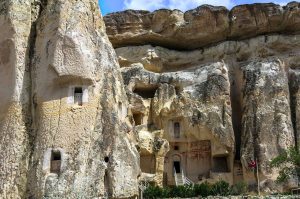More than 4,8 million domestic and foreign tourists visited Cappadocia in Turkey last year. Central Anatolia has thus established itself as one of the country's leading tourism centers and even set a new visitor record.
Cappadocia is not only known for its bizarre rock cone formations, the so-called “fairy chimneys”. Underground cities, museums and traditional craft demonstrations provide a deep insight into the region's history and culture. Especially in spring - when the vegetation is blooming, there is still snow on the high mountain peaks and the main tourist season has not yet begun - it is worth visiting this UNESCO World Heritage Site. For those who prefer a comfortable journey, Corendon Airlines offers flights to this diverse area.
The landscape in the plateau consists predominantly of soft tuff rock that has solidified from volcanic ash. People dug passages, stairs and caves there as early as the Bronze Age. Later, from the 5th to the 14th century, the first Christians created a labyrinth of homes, churches and monasteries in this barren landscape. Here is a small selection of the most interesting sights in Cappadocia.
Kaymakli and Derinkuyu: These two underground cities are believed to be among the largest of their kind in the world. The complex tunnel networks are said to have housed several thousand people. Kaymakli alone reaches up to eight floors deep, five of which are open to the public. The remains of a cave church, the ramified living areas and a sophisticated ventilation system continue to fascinate visitors from all over the world to this day.
The underground city of Özkonak is located around 60 kilometers from Derinkuyu. It may be less well known, but it is still worth a detour. The site is particularly worth seeing for its circular structure and the detailed corridors and rooms that were skillfully carved into the rock by its builders.
Mazi is an insider tip among the historical sights of Cappadocia. It is smaller than other underground cities, but stands out for its well-preserved, detailed frescoes. The story goes back to the 2nd century BC. BC and was used intensively, especially during the Roman period.
The open-air museum in the town of Göreme is also a UNESCO World Heritage Site. Presumably between the 10th and 12th centuries, monks created a monastery complex at this site and carved several churches into the tuff. There are also particularly impressive frescoes and murals here, including those of Saint George, who was born in Cappadocia.
The museums in the towns of Ürgüp and Avanos provide a fascinating insight into the cultural and historical heritage of Cappadocia. In Ürgüp, visitors can admire an impressive collection of artifacts including traditional Turkish carpets, known for their plush texture, as well as kilims, characterized by their flat weave technique and geometric designs. There are also exhibitions about the early Christian communities. The museum in Avanos is dedicated to the region's traditional crafts, including pottery and carpet weaving, which are presented in demonstrations.
The fascinating landscape is best admired from a height of several hundred meters during a balloon ride, an activity for which the region is famous. This offers a unique perspective during a journey lasting several hours over valleys and rock formations.
For an authentic overnight experience, the “cave hotels” in Göreme, Ürgüp and Ortahisar, among others, offer modern amenities in an ancient setting carved into sandstone. These accommodations are booked up quickly, not only in high season, which is why it is strongly recommended to reserve well in advance.
The Cappadocia region, with its provincial capital Nevşehir, is only about an hour's drive from Kayseri Airport. Corendon Airlines serves the airport from Düsseldorf in winter and spring; In the summer season there are flights to the airport from Düsseldorf, Hanover, Cologne and Nuremberg. This allows for convenient travel and gives visitors the opportunity to quickly immerse themselves in the heart of this historically and culturally rich region.




